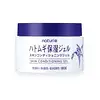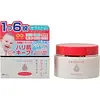What's inside
What's inside
 Key Ingredients
Key Ingredients

 Benefits
Benefits

 Concerns
Concerns

 Ingredients Side-by-side
Ingredients Side-by-side

Water
Skin ConditioningGlycerin
HumectantDipropylene Glycol
HumectantDimethicone
EmollientTetrahexyldecyl Ascorbate
AntioxidantTocopheryl Phosphate
CleansingCoix Lacryma-Jobi Ma-Yuen Seed Extract
Skin ConditioningCholesteryl/Octyldodecyl Lauroyl Glutamate
Skin ConditioningAcrylates/C10-30 Alkyl Acrylate Crosspolymer
Emulsion StabilisingAmmonium Acryloyldimethyltaurate/Vp Copolymer
Butylene Glycol
HumectantPEG-12 Dimethicone
Skin ConditioningSodium Hydroxide
BufferingCarbomer
Emulsion StabilisingPhytosteryl Isostearyl Dimer Dilinoleate
EmollientOctyldodecyl Myristate
EmollientTocopherol
AntioxidantMethylparaben
PreservativeWater, Glycerin, Dipropylene Glycol, Dimethicone, Tetrahexyldecyl Ascorbate, Tocopheryl Phosphate, Coix Lacryma-Jobi Ma-Yuen Seed Extract, Cholesteryl/Octyldodecyl Lauroyl Glutamate, Acrylates/C10-30 Alkyl Acrylate Crosspolymer, Ammonium Acryloyldimethyltaurate/Vp Copolymer, Butylene Glycol, PEG-12 Dimethicone, Sodium Hydroxide, Carbomer, Phytosteryl Isostearyl Dimer Dilinoleate, Octyldodecyl Myristate, Tocopherol, Methylparaben
Water
Skin ConditioningGlycerin
HumectantButylene Glycol
HumectantIsopentyldiol
HumectantPEG-240/Hdi Copolymer Bis-Decyltetradeceth-20 Ether
StabilisingCeramide 1
Skin ConditioningCeramide 3
Skin ConditioningCeramide 6 Ii
Skin ConditioningHydrolyzed Collagen
EmollientSodium Hyaluronate
HumectantPhytosphingosine
Skin ConditioningCholesterol
EmollientCarbomer
Emulsion StabilisingSodium Hydroxide
BufferingLauric Acid
CleansingSodium Lauroyl Lactylate
EmulsifyingXanthan Gum
EmulsifyingPhenoxyethanol
PreservativeDisodium EDTA
Benzophenone-3
UV AbsorberBHT
AntioxidantEthylparaben
PreservativeMethylparaben
PreservativePropylparaben
PreservativeWater, Glycerin, Butylene Glycol, Isopentyldiol, PEG-240/Hdi Copolymer Bis-Decyltetradeceth-20 Ether, Ceramide 1, Ceramide 3, Ceramide 6 Ii, Hydrolyzed Collagen, Sodium Hyaluronate, Phytosphingosine, Cholesterol, Carbomer, Sodium Hydroxide, Lauric Acid, Sodium Lauroyl Lactylate, Xanthan Gum, Phenoxyethanol, Disodium EDTA, Benzophenone-3, BHT, Ethylparaben, Methylparaben, Propylparaben
 Reviews
Reviews

Ingredients Explained
These ingredients are found in both products.
Ingredients higher up in an ingredient list are typically present in a larger amount.
Butylene Glycol (or BG) is used within cosmetic products for a few different reasons:
Overall, Butylene Glycol is a safe and well-rounded ingredient that works well with other ingredients.
Though this ingredient works well with most skin types, some people with sensitive skin may experience a reaction such as allergic rashes, closed comedones, or itchiness.
Learn more about Butylene GlycolCarbomer is a polymer of acrylic acid. Its main role is to create a gel consistency.
A high amount of carbomer can cause pilling or balling up of products. Don't worry, most products contain 1% or less of carbomer.
Glycerin is already naturally found in your skin. It helps moisturize and protect your skin.
A study from 2016 found glycerin to be more effective as a humectant than AHAs and hyaluronic acid.
As a humectant, it helps the skin stay hydrated by pulling moisture to your skin. The low molecular weight of glycerin allows it to pull moisture into the deeper layers of your skin.
Hydrated skin improves your skin barrier; Your skin barrier helps protect against irritants and bacteria.
Glycerin has also been found to have antimicrobial and antiviral properties. Due to these properties, glycerin is often used in wound and burn treatments.
In cosmetics, glycerin is usually derived from plants such as soybean or palm. However, it can also be sourced from animals, such as tallow or animal fat.
This ingredient is organic, colorless, odorless, and non-toxic.
Glycerin is the name for this ingredient in American English. British English uses Glycerol/Glycerine.
Learn more about GlycerinMethylparaben is a preservative and is a paraben. It is used to prevent the growth of fungus, mold, and other harmful bacteria. Parabens are chemicals used as preservatives in both cosmetics and food.
Methylparaben can be synthetically created. It can also be found naturally in some fruits, such as blueberries.
Oftentimes, Methylparaben is combined with other parabens to help increase the shelf life.
The safety of Methylparaben is currently being studied. While ongoing studies are looking into the safety of parabens, the results have been very mixed. Some studies have not found Methylparaben to be harmful.
Learn more about MethylparabenSodium Hydroxide is also known as lye or caustic soda. It is used to adjust the pH of products; many ingredients require a specific pH to be effective.
In small amounts, sodium hydroxide is considered safe to use. However, large amounts may cause chemical burns due to its high alkaline.
Your skin has a natural pH and acid mantle. This acid mantle helps prevent harmful bacteria from breaking through. The acid mantle also helps keep your skin hydrated.
"Alkaline" refers to a high pH level. A low pH level would be considered acidic.
Learn more about Sodium HydroxideWater. It's the most common cosmetic ingredient of all. You'll usually see it at the top of ingredient lists, meaning that it makes up the largest part of the product.
So why is it so popular? Water most often acts as a solvent - this means that it helps dissolve other ingredients into the formulation.
You'll also recognize water as that liquid we all need to stay alive. If you see this, drink a glass of water. Stay hydrated!
Learn more about Water